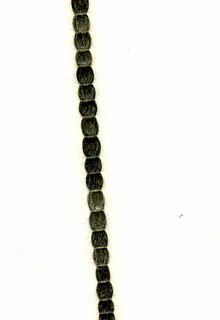Chaetomorpha melagonium: Difference between revisions
Content deleted Content added
Not an orphan |
m Copying from Category:Ulvophyceae stubs to Category:Chlorophyta species using Cat-a-lot |
||
| (13 intermediate revisions by 9 users not shown) | |||
| Line 1: | Line 1: | ||
{{Short description|Species of alga}} |
|||
{{unreferenced|date=December 2014}} |
|||
{{more citations needed|date=January 2021}} |
|||
{{italic title}} |
|||
{{Speciesbox |
|||
{{Taxobox |
|||
| name = ''Chaetomorpha melagonium'' |
|||
| image = Chaetomorpha melagonium Detail.jpg |
| image = Chaetomorpha melagonium Detail.jpg |
||
| image_caption = Detail of a strand of ''Chaetomorpha melagonium'' dried in an [[herbarium]] |
| image_caption = Detail of a strand of ''Chaetomorpha melagonium'' dried in an [[herbarium]] |
||
| |
| genus = Chaetomorpha |
||
| ⚫ | |||
| divisio = [[Chlorophyta]] |
|||
| ⚫ | |||
| classis = [[Ulvophyceae]] |
|||
| ordo = [[Cladophorales]] |
|||
| familia = [[Cladophoraceae]] |
|||
| genus = [[Chaetomorpha]] |
|||
| ⚫ | |||
| binomial = ''Chaetomorpha melagonium'' |
|||
| ⚫ | |||
}} |
}} |
||
'''''Chaetomorpha melagonium''''' is a species of [[green algae]] of the family ''[[Cladophoraceae]]''. |
'''''Chaetomorpha melagonium''''' is a species of [[green algae]] of the family ''[[Cladophoraceae]]''. |
||
| Line 21: | Line 15: | ||
==Description== |
==Description== |
||
The attached form is unbranched growing solitary or in a small group to 60 cm long. The filaments are attached at the base and are stiff and straight. In colour they are dark green with a glaucus sheen.<ref name="Burrows"/> Remarkably rigid and wiry.<ref>Harvey, W.H. 1841. ''A Manual of the British Algae:'' London</ref> |
The attached form is unbranched growing solitary or in a small group to 60 cm long. The filaments are attached at the base and are stiff and straight. In colour they are dark green with a glaucus sheen.<ref name="Burrows"/> Remarkably rigid and wiry.<ref>Harvey, W.H. 1841. ''A Manual of the British Algae:'' London</ref> The cells are so large they can be seen with naked eye.<ref name="Hardy">Hardy, F.G. and Guiry, M.D.2003. ''A Check-list and Atlas of the Seaweeds of Britain and Ireland''. The British Phycological Society {{ISBN|09527115 16}}</ref> |
||
==Habitat== |
==Habitat== |
||
Rock pools of the low littoral.<ref name="Burrows"/> Never abundant |
Rock pools of the low littoral.<ref name="Burrows"/> Never abundant,<ref>Newton, J. 1931. ''A Handbook of the British Seaweeds''. British Museum, London</ref> but widespread. |
||
==Distribution== |
==Distribution== |
||
Widespread around the British Isles, along the Atlantic shores of Europe, Murman Sea, Greenland, Canadian Arctic.<ref name="Burrows"/> |
Widespread around the British Isles, along the Atlantic shores of Europe, Murman Sea, Greenland, Canadian Arctic.<ref name="Burrows"/> |
||
== |
==References== |
||
{{ |
{{Reflist}} |
||
{{Taxonbar|from=Q2947556}} |
|||
[[Category:Cladophoraceae]] |
[[Category:Cladophoraceae]] |
||
[[Category:Plants described in 1845]] |
[[Category:Plants described in 1845]] |
||
[[Category:Taxa named by Friedrich Traugott Kützing]] |
|||
[[Category:Chlorophyta species]] |
|||
Latest revision as of 13:05, 15 April 2024
This article needs additional citations for verification. (January 2021) |
| Chaetomorpha melagonium | |
|---|---|

| |
| Detail of a strand of Chaetomorpha melagonium dried in an herbarium | |
| Scientific classification | |
| (unranked): | Viridiplantae |
| Division: | Chlorophyta |
| Class: | Ulvophyceae |
| Order: | Cladophorales |
| Family: | Cladophoraceae |
| Genus: | Chaetomorpha |
| Species: | C. melagonium
|
| Binomial name | |
| Chaetomorpha melagonium | |
Chaetomorpha melagonium is a species of green algae of the family Cladophoraceae.
There is confusion as to whether there are two forms of this species - one attached and one unattached.[1]
Description[edit]
The attached form is unbranched growing solitary or in a small group to 60 cm long. The filaments are attached at the base and are stiff and straight. In colour they are dark green with a glaucus sheen.[1] Remarkably rigid and wiry.[2] The cells are so large they can be seen with naked eye.[3]
Habitat[edit]
Rock pools of the low littoral.[1] Never abundant,[4] but widespread.
Distribution[edit]
Widespread around the British Isles, along the Atlantic shores of Europe, Murman Sea, Greenland, Canadian Arctic.[1]
References[edit]
- ^ a b c d Burrows, E.M. 1991. Seaweeds of the British Isles Volume 2 Chlorophyta. Natural History Museum, London ISBN 0-565-00981-8
- ^ Harvey, W.H. 1841. A Manual of the British Algae: London
- ^ Hardy, F.G. and Guiry, M.D.2003. A Check-list and Atlas of the Seaweeds of Britain and Ireland. The British Phycological Society ISBN 09527115 16
- ^ Newton, J. 1931. A Handbook of the British Seaweeds. British Museum, London
